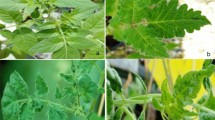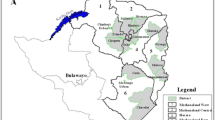Abstract
Received April 24, 1997; received in final form June 29, 1997. Symptoms resembling tomato spotted wilt virus (TSWV) infections were documented among ornamental and vegetable crops in commercial greenhouses and open fields in Israel. Plants exhibiting these symptoms were collected from January 1992 to December 1996. Among cultivated plants analyzed for TSWV by enzyme-linked immunosorbent assay (ELISA), 19 species representing five families were found to be infected; natural infection was also recorded in six plant species of weeds. Virus identity was characterized by host range, serology and electron microscopy. Serological reaction with the isolates, found in Israel, using antisera from different sources as well as the sequence analysis of the nucleocapsid gene, demonstrated that the Israeli isolates of TSWV are a member of tospovirus serogroup I, type I (BR-01 strain). No virus transmission was found in seeds collected from virus-infected vegetable and ornamental crops. A non-radioactive molecular probe derived from the cloned nucleocapsid isolate enables specific detection of the virus in crude sap from infected plants. The detection of TSWV in Israel constitutes a severe potential threat to the ornamental and vegetable industry.
Similar content being viewed by others
References
Adam, G., Lesemann, D. E. and Vetten, H. J. (1991) Monoclonal antibodies against tomato spotted wilt virus: characterization and application.Ann. Appl. Biol. 118:87–104.
Antignus, Y., Gera, A., Pearlsman, M., Ben-Joseph, R., Ganaim, N., Raccah, B. and Cohen, S. (1994) Tomato spotted wilt, a new disease of flowers and vegetables in Israel.Phytoparasitica 22:86–87 (abstr.).
Ben-Dov, Y., Wysoki, M., Tomer, E., Ofek, G. and Avin, Z. (1992) [Observations on the phenology and control of the western flower thripsFrankliniella occidentalis Pergande of mango inflorescences in Israel.]Alon haNotea 46:497–503 (in Hebrew).
Crosslin, J. M., Hammond, R. W. and Hammerschlag, F. A. (1992) Detection ofPrunus necrotic ringspot virus serotypes in herbaceous andPrunus hosts with a complementary RNA probe.Plant Dis. 76:1132–1136.
Crowley, N. C. (1957) Studies on the seed transmission of plant virus diseases.Aust. J. Biol. Sci. 10:449–454.
Davis, R. F. and Hampton, R. O. (1986) Cucumber mosaic virus isolates seedborne inPhaseolus vulgaris.Phytopathology 76:999–1004.
de Avila, A. C., Huguenot, C, Resende, R. de O., Kitajima, E. W., Goldbach, R. and Peters, D. (1990) Serological differentiation of 20 isolates of tomato spotted wilt virus.J. Gen. Virol. 71:2801–2807.
de Haan, P., Kormelink, L., Resende, R. de O., Poellwijk, F. van, Peters, D. and Goldbach, R. (1991) Tomato spotted wilt virus L RNA encodes a putative RNA polymerase.J. Gen. Virol. 72:2207–2216.
de Haan, P., Wagemakers, L., Peters, D. and Goldbach, R. (1991) The S RNA segment of tomato spotted wilt virus has an ambisense character.J. Gen. Virol. 71:1001–1007.
Francki, R. I. B., Fauquet, CM., Knudson, D. L. and Brown, F. (1991) Classification and nomenclature of viruses: Fifth report of the International Committee on Taxonomy of Viruses.Arch. Virol. Suppl. 2.
Gera, A., Ganaim, N. and Cohen, J. (1994) [Tomato spotted wilt virus in ornamental crops.]Dapey Medaa 4:68–69 (in Hebrew).
German, T. L., Ullman, D. E. and Moyer, J. W. (1992) Tospoviruses: diagnosis, molecular biology, phylogeny and vector relationships.Annu. Rev. Phytopathol. 30:315–348.
Goldbach, R. and Peters, D. (1994) Possible causes of the emergence of tospovirus diseases.Sem. Virol. 3:113–120.
Jones, L. K. (1944) Streak and mosaic ofCineraria.Phytopathology 34:941–953.
Laemmli, U. K. (1970) Cleavage of structural proteins during the assembly of the head of the bacteriophage T4.Nature (Lond.) 227:680–685.
Maiss, E., Ivanova, L., Breyel, E. and Adam, G. (1991) Cloning and sequencing of the S RNA from a Bulgarian isolate of tomato spotted wilt virus.J. Gen. Virol. 72:461–464.
Mohammed, N. A., Randies, J. W. and Francki, R. I. B. (1973) Protein composition of tomato spotted wilt virus.Virology 56:12–21.
Mumford, R. A., Barker, I. and Wood, K. R. (1996) The biology of tospoviruses.Ann. Appl. Biol. 128:159–183.
Peters, D., de Avila, A. C., Kitajima, E. W., Resende, R. de O., De Haan, P. and Goldbach, R. (1991) An overview of tomato spotted wilt virus.in: Hsu, H. T. and Lawson, R. H. [Eds.]Proc. USDA Workshop Virus-Thrips Plant Interactions of Tomato Spotted Wilt Virus (Beltsville, MD, USA), pp. 1–14.
Rice, D. J., German, T. L., Mau, F. L. and Fujimoto, F. M. (1990) Dot blot detection of tomato spotted wilt virus RNA in plant and thrips tissues by cDNA clones.Plant Dis. 74:274–276.
Towbin, H., Staehelin, T. and Gordon, J. (1979) Electrophoretic transfer of proteins from polyacrylamide gels to nitrocellulose sheets: procedure and some applications.Proc. Natl. Acad. Sci. USA 76:4350–4354.
Ullman, D. E., Cho, J. J., Mau, R. F. L., Hunter, W. B., Westcot, D. M. and Custer, D. M. (1992) Thrips tomato spotted wilt virus interactions: morphological, behavioral and cellular components influencing thrips transmission.Adv. Dis. Vector Res. 9:196–240.
Ullman, D. E., Cho, J. J., Mau, R. F. L., Westcot, D. M. and Custer, D. M. (1992) A midgut barrier to tomato spotted wilt virus acquisition by adult Western Flower Thrips.Phytopathology 82:1333–1342.
Verhoeven, J. Th. J. (1992) Tomatebronsvlekkenvirus: Steeds meer slachtoffers.Vakbl. Bloemisterij 50:28–33.
Verhoeven, J. Th. J. and Roenhorst, J. W. (1995) Tomato spotted wilt virus: Ecological aspects in ornamental crops in the Netherlands from 1989 up to 1991.Acta Hortic. 377:175–183.
Verhoeven, J. Th. J., Roenhorst, J. W., Cortes, I. and Peters, D. (1996) Detection of a novel tospovirus in chrysanthemum.Acta Hortic. 432:44–52.
Verwoerd, T. C., Dekker, B. M. M. and Hoekama, A. (1989) A small-scale procedure for the rapid isolation of plant RNAs.Nucl. Acid Res. 17:2362.
Wijkamp, I., Van Lent, J., Kormelink, R., Goldbach, R. and Peters, D. (1993) Multiplication of tomato spotted wilt virus in its insect vector,Frankliniella occidentalis.J. Gen. Virol. 74:341- 349.
Author information
Authors and Affiliations
Corresponding author
Rights and permissions
About this article
Cite this article
Antignus, Y., Lapidot, M., Ganaim, N. et al. Biological and molecular characterization of Tomato spotted wilt Virus in Israel. Phytoparasitica 25, 319–330 (1997). https://doi.org/10.1007/BF02981095
Issue Date:
DOI: https://doi.org/10.1007/BF02981095




